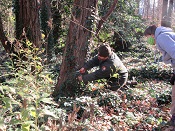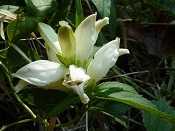
FODMers Shine in Photography Showcase

Virginia Wildlife magazine chose the photographs of two talented members of the Friends of Dyke Marsh for the magazine’s annual Photography Showcase, published in the July-August 2021 issue: Barbara Saffir and Jane Gamble. Congratulations!
Volunteers Continue Insect Surveys

Since 2016, devoted volunteers have surveyed Dyke Marsh for butterflies, dragonflies and damselflies once a month, often observing many other insects and wildlife too. Here are a few examples of 2021 sightings. Thank you, Rusty Moran, for your observations and photographs.
The first photo is the gray hairstreak butterfly (Strymon melinus). As its name suggests, this species of butterfly belongs to a group of butterflies with hairlike markings on the underside of their wings. Fairly common, this species lives in a variety of habitats. Its caterpillars feed on a variety of plants.
The Potomac River's Recovery May Be Stalling

The Potomac River is much cleaner today than it was in 1964 when then U.S. President Lyndon Johnson called it “a national disgrace,” but efforts are still needed to get it to an A grade, Hedrick Belin, President of the Potomac Conservancy, told attendees of a May 26, 2021, Zoom meeting of the Friends of Dyke Marsh. “It is still too polluted for swimming and fishing,” he cautioned.
Determining the Habitat Quality of an Area Stream

On April 9 and May 27, 2021, FODM volunteers conducted habitat quality monitoring in an unnamed, intermittent stream that flows through Mount Vernon Park into west Dyke Marsh. FODM started this project in 2016.
On May 27, the stream had the highest number of macroinvertebrates that FODM volunteers have ever seen there – 206. “Although most were midges, it was still very, very exciting,” observed Ashley Palmer, Northern Virginia Soil and Water Conservation District (NVSWCD), who led the group. Palmer explains, “Midges are small macroinvertebrates considered to be tolerant of pollution. Finding many midges in a stream usually indicates poor water quality, but at this site we likely find more midges due to the intermittent stream flow which can make it more difficult for more sensitive species to be present. A healthy stream has a large number and wide variety of macroinvertebrates.”
Barred Owls Boost Spirits

Spring’s rebirth is always uplifting, especially when Dyke Marsh’s avian heroes and heroines put on a show. In May 2021, many people delighted in observing a barred owl pair (Strix varia) and their three young near the Haul Road trail.
Josh Brick shared a video of the two adults appearing to display affection or preening. “It was hard to pull ourselves away,” Josh reported.
Bald Eagles and Ospreys Put on a Show

In early May 2021, the eaglet pair in one of the nests in Dyke Marsh is growing up. They are often visible to visitors. The flapping eaglet is exercising its wing muscles, in preparation for flight. Young bald eagles typically fledge in Northern Virginia in June.
In these stunning photographs by Ashley Bradford taken on May 2, one of the eaglets leapt up and flapped and got up above the edge of the nest before dropping back down into it.
Volunteers Are Saving Dyke Marsh’s Trees

In 2021 in five sessions, as of April 4, 2021, FODM volunteers have collected 136 bags of English ivy off trees, an effort to save the trees.
English ivy (Hedera helix L.) is an invasive, evergreen, aggressive invader that can outcompete and smother native plants, block sunlight needed by herbs and seedlings and spread into the forest canopy.
Flying Squirrels Wow the Crowd

On February 17, 2021, 89 people became instant fans of the native southern flying squirrel (Glaucomys volans) thanks to a much-applauded Zoom presentation by naturalist Kim Young, from Fairfax County Park Authority’s Hidden Oaks Nature Center.
Ms. Young detailed the identifying characteristics, behavior, diet and habitat of these members of the rodent family, animals that weigh about the same as a cellphone, 2 ½ ounces, and are eight inches long, with their tail being from a third to a half of that length.
Plants Shaped by Water

“Water is essential for all life,” explained Charles Smith, opening his talk on November 10, 2020, a presentation titled “Plants Shaped by Water.” No matter where plants are, they need water, from a little carnivorous sundew to wetland pickerelweed to giant oak trees. Some systems, like saltwater and freshwater wetlands, are defined by water. Smith is a branch chief with the Fairfax County Stormwater Planning Division, a certified ecological restoration practitioner and a Virginia master naturalist instructor.
Sora Heard in the Marsh

The sora (Porzana Carolina) is the most abundant and widely distributed species of marsh-loving birds called rails (family Rallidae) in North America. In the 1960s, they were frequently seen in migration at Dyke Marsh, according to surveys conducted by Jackson Abbott.
Today, they are rarely encountered, so it was a rare treat when people heard at least five in the marsh in the early morning hours of October 18, 2020. “The sora makes its presence known with plaintive whistles and whinnies,” wrote Kenn Kaufman in Lives of North American Birds. This rail is mottled brown and gray with white-edged feathers, around eight to ten inches in length, two to four ounces in weight, has a bright yellow “candy corn” bill and nervously flicks its tail.
Dyke Marsh Volunteers Survey Insects

Since 2016, volunteers from FODM and the Audubon Society of Northern Virginia have conducted surveys of butterflies, dragonflies and damselflies in Dyke Marsh from April to October. Here are the total numbers of species documented from 2016 through September 23, 2020: butterflies, 50 species; damselflies, 12 species; dragonflies, 37 species. While surveying, they also document other insects.
Pandemic Pollution: More Trash

Friends of Dyke Marsh volunteers typically collect 30 bags of trash along the Potomac River shoreline during two-hour cleanups. On September 26, 2020, 17 volunteers filled 42 bags.
One consequence of the coronavirus pandemic in 2020 has been a substantial increase the amount of trash on our streets, parking lots and land, much of which ultimately ends up in our waterways. Observers often find wipes, masks and rubber gloves littered across the landscape. With more people ordering takeout food, there appears to be an increase in food packaging materials as well.


AlbertHerring-b4cc6b5cfb.jpg)



 Friends of Dyke Marsh, Inc. is a non-profit 501(c)(3) organization.
Friends of Dyke Marsh, Inc. is a non-profit 501(c)(3) organization.